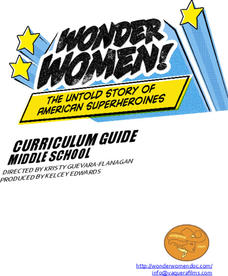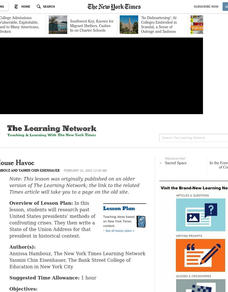Curated OER
Compare/Contrast: The United States and Alaska Constitutions
Students compare and contrast the United States and Alaska Constitution. After reading each preamble, they identify the reasons for each constitution to be drafted and discuss what they reveal about citizens responsiblity in government....
Curated OER
United States-Japan History
Students compare the histories of Japan and the United States by creating horizontal time lines of the two countries. They conduct research via the internet and available text books to complete their time line. The class discusses the...
Curated OER
Bio-Poems and U.S. History
Students explore U.S. History by writing poems. For this United States leader biography lesson, students identify elements needed to create a good poem, and write a Bio-Poem about themselves. Students utilize the same form to write a...
Curated OER
Puerto Rico . . . Its Land, History, Culture, and Literature
Students examine Puerto Rico's location and from its geographic location, reflect on its culture and people. They also read a play by a Puerto Rican author. This is an excellent cross-curricular unit, including history, geography, and...
Curated OER
Prosperity and Challenges
High schoolers watch a slideshow about the technological advances in agriculture. After viewing, they complete an index card about one aspect of the slideshow. In groups, they create a cause and effect timeline in which they identify...
Curated OER
History of Political Parties in the U. S.
Twelfth graders name some of the parties in the political system of the United States. They identify the two main parties along with key information, issues, events, elections and/or people for each system. They then break into groups...
Sharp School
The Bill of Rights and Supreme Court Cases Project
Social media and United States history combine as your young historians design a Facebook page for two major defendants of landmark Supreme Court cases. The resource includes a detailed rubric for research and page design, as well as a...
Curated OER
Read All About It! California History of the 30s and 40s
Explore the Great Depression! Discover the challenges people experienced during the time period. Learners investigate photographs from the Dust Bowl and WWII era and create a story line about the photographs, writing a newspaper article...
Vaquera Films
Wonder Women - The Untold Story of American Superheroines: Middle School Curriculum Guide
Women in power are the focus of a three-module unit that employs comic books to bring home the importance of equality and proficient media literacy skills. In module one, scholars examine gender roles in media—boosting media literacy and...
Smithsonian Institution
The Price of Freedom: Americans at War
An interactive resource covers all of the United States' most prominent and influential historic wars including the Vietnam War, the Cold War, the War of 1812, and the Korean War. Learners observe cause and effect as well as how violence...
Curated OER
Immigration in the United States
Pupils examine the reasons why people leave their country to live in another. In groups, they use print and electronic resources to answer questions about where immigrants came from during different time periods and advice given to...
Curated OER
Prince Hall and His Organization of Black Free Masons in the United States
Students examine the life of Prince Hall who became a member of the Free Masons during the time period of slavery. Depending on the grade level, they are shown pictures or read a reference guide listing the characteristics of each...
Curated OER
Solving the Puzzle
Students create a map showing the United States borders at a specific period in history and produce three questions to be answered by examining the map. They also write a productive paragraph explaining who, what, when, where, how/why a...
Annenberg Foundation
Contested Territories
United States expansion into Western territories impacted much more than just lines on a map. The seventh installment of a 22-part series about America's history puts scholars into the lives of those making the journey westward as well...
West Virginia Department of Education
History Scene Investigators - John Brown's Raid
An informative resource covers the event of John Brown's Raid, an event that became an important part of West Virginia history. It serves as a standalone and covers the event and John Brown's life in depth using group work, online...
Annenberg Foundation
The New Nation
The conclusion of the American Revolution brought about a new conflict—choosing the stye of government for the newly formed United States. Using the views of both Federalists and Anti-Federalists, learners work in pairs and groups to...
Curated OER
White House Havoc
The president of the United States must be able to keep a cool head in moments of crisis to lead his or nation out of the darkness. A history instructional activity encourages learners to study the ways various presidents have handled...
Curated OER
Coming to America
Through this set of three lessons about Ellis Island, class members will learn about why immigrants came to the United States, find out about the difficulties that went along with coming to America, become familiar with the immigration...
Tennessee State Museum
An Emancipation Proclamation Map Lesson
Did the Emancipation Proclamation free all slaves during the Civil War? Why was it written, and what were its immediate and long-term effects? After reading primary source materials, constructing political maps representing information...
Advocates for Human Rights
Who are Immigrants?
What do Jerry Yang, Patrick Ewing, John Muir, Charlize Theron, Peter Jennings, and Saint Frances X Cabrini all have in common? They are all immigrants to the United States. Famous and not-so-famous immigrants are the focus of a resource...
Alabama Department of Archives and History
Alabama's Secession in 1861: Embraced with Joy and Great Confidence. Why?
From December 20, 1860 to June 8, 1861, eleven states seceded from the Union. Alabama seceded on January 11, 1861. Why did so many white Alabamians want to secede? Why did they believe the South could win the war? These are the essential...
National Endowment for the Humanities
Lost Hero: Was John Hanson Actually the First President?
The first president of the United States was ... John Hanson? Scholars investigate the notion that the initial leader of the nation was not George Washington. Using research, articles, and open discussion, individuals create a quest for...
National Endowment for the Humanities
The Preamble to the Constitution: A Close Reading Lesson
"We the people of the United States, in order to form a more perfect union..." These familiar lines begin the Preamble to the Constitution, but do learners know what they mean? A close reading exercise takes a look at the language of the...
Curated OER
Early Presidents
Students are introduced to the lives and contributions of the first seven presidents of the United States. They, in groups, conduct further research on one of these president and his political platform and design a presentation for the...
Other popular searches
- United States History 1920s
- United States History 1900's
- United States History 1700's
- United States History Essays
- Ap United States History
- Media United States History
- United States History K 2
- History of United States
- United States History Exam
- United States History Colonial
- United States History Units
- United States History Timeline

























